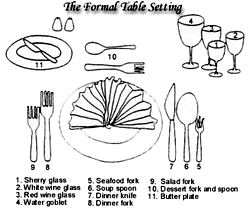03/01/2004
Previous | Next | Career Corner Home | Health | Issues | Personal Finance

Times change and this affects the guidelines of etiquette. Common sense will typically be your best guide, but it is helpful to have some general ideas regarding dining and business etiquette.
Dining Etiquette
It is important to know how to conduct oneself properly at the table. The rules of dining etiquette are fairly straightforward and mostly require common sense.
Table Setting
It can be very confusing to be presented with a variety of eating utensils. (See diagram) Remember the guideline "to start at the outside and work your way in." If you have been given two forks, which are the same size, begin with the fork on the outside. Many restaurants use the same size of fork for both the salad and main course.
Napkin
When dining with others place your napkin on your lap after everyone at your table has been seated. Do not open your napkin in mid-air. As you remove your napkin from the table begin to open below the table level and place on your lap. If you must leave a meal, do so between courses, and place your napkin on your chair or to the left of your plate. When a meal is completed, place your napkin to the right of your plate -- never on the plate.
Served
Wait for everyone at your table to be served before beginning to eat. However, if an individual who has not been served encourages you to begin eating, you may do so. Eat slowly while waiting for their food to be served.
Soup
When eating soup, think of making a circle: spoon away from you, bring around to your mouth and back to the bowl. Soup is taken from the side of the soup spoon -- it is not inserted into your mouth. Do not slurp or make noises when eating soup.
Utensils
Be careful how you hold your utensils. Many people tend to make a fist around the handle of the utensil -- this is the way a young child would grasp a utensil (not an adult). There are two acceptable ways to use the knife and fork: continental fashion and American standard. Continental fashion; the diner cuts the food usually one bite at a time and uses the fork in the left hand, tines pointing down, to spear the food and bring it to the mouth. American standard; a few bites are cut, the knife is laid across the top of the plate, sharp edge toward you, and the fork is switched to the right hand, if right-handed, tines up to bring the food to the mouth. (Do not cut more than two or three bites at a time.)
Dessert Utensils
Dessert utensils may be found placed across the top of the place setting. Slide these utensils down for use after the main course is removed (fork to the left and spoon to the right).
Passing
Pass "community food" such as the breadbasket, salt and pepper, and salad dressing to the right. Always pass the salt and pepper together. When passing items such as a creamer, syrup pitcher or gravyboat, pass it with the handle pointing toward the recipient.
Seasoning
Always taste your food first before using any seasonings. Do not assume it needs to be seasoned.
Bread
Bread/rolls should never be eaten whole. Break into smaller, more manageable pieces, buttering only a few bites at a time. Toast and garlic bread however may be eaten as whole pieces since they are usually already buttered. If you are served a piping hot muffin or biscuit, you may break in half crosswise, butter and put back together. However when ready to actually eat, break it into small pieces.
Glasses
A variety of types and sizes of glasses can be used throughout the meal. Remember your items to drink will be located in the area above your knife and spoon. Coffee cups may be located to the right of the knife and spoon.
Finished
When finished with a course, leave your plates in the same position that they were presented to you. In other words, do not push your plates away or stack them.
[Editor's note: It is also recommended that knife and fork be placed diagonally across the plate in a "10:00 o'clock-4:00 o'clock" position. The fork should be to the left of the knife with tines down, and the sharp edge of the knife should face inward towards the fork.]
Guest
If you are someone's guest at a meal, ask the person what he/she recommends. By doing this, you will learn price range guidelines and have an idea of what to order. Usually order an item in the mid price range. Also keep in mind, the person who typically initiates the meal will pay.
There are many things to keep in mind when dining, but as always common sense should be your guide. When dining with a prospective employer remember it may look like lunch/dinner but it's still business. The way you act during a meal will have impact on an interviewer's hiring decision and your future.
Social skills can help us build more productive relationships. In these changing times, one needs to prepare for a variety of encounters in both the business and social environments.
Courtesy of The University of Tennessee Career Services.
© 2004 The University of Tennessee Career ServicesThe views and opinions expressed in these articles do not necessarily reflect those of College Central Network, Inc. or its affiliates. Reference to any company, organization, product, or service does not constitute endorsement by College Central Network, Inc., its affiliates or associated companies. The information provided is not intended to replace the advice or guidance of your legal, financial, or medical professional.